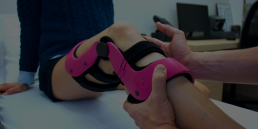Flat feet (or flatfoot) is a common condition where there is a collapse of the arch of the foot over time, resulting in increased contact of the foot with the ground.
This condition can cause various symptoms, including foot pain, increased fatigue while walking, instability and difficulty maintaining balance, or a risk of developing other foot problems such as plantar fasciitis or bunions.
In this article, EVO presents the treatments available to relieve flat feet symptoms and improve your quality of life.
Plantar Orthotics
Plantar orthotics (or orthopedic inserts) are medical devices designed to support the foot’s arch in the shoe and correct biomechanical imbalances. They are the first solution to consider when treating flat feet.
How do they work? Orthoses support the arch of the foot and redistribute the body’s weight evenly. They are customized to fit your foot structure for optimal support and pain reduction.
Choose orthoses made from high-quality materials to ensure comfort and durability. Materials such as Poron or Podiane can cushion and reduce pressure on sensitive foot areas.
Orthopedic Shoes
Orthopedic shoes offer another solution for flat feet. Indeed, they provide a stable structure that helps correct excessive pronation and relieve pressure on the foot joints. When choosing your orthopedic shoes, opt for those with a removable insole to accommodate custom orthoses. Also, look for models with good arch support, Velcro straps (for pain-free backing), a stable heel, and breathable materials for comfort.
Physiotherapy and Stretching
Muscle Strengthening
Physiotherapy is crucial in healing flat feet by strengthening the foot, ankle, and leg muscles. Your physiotherapist can prescribe specific exercises to improve their stability and flexibility and reduce excessive pronation associated with flat feet.
Relief Techniques
Physiotherapy sessions may also include massage and stretching techniques to relieve tension and muscle pain. These therapeutic approaches aim to improve mobility and promote better posture in people with flat feet.
Exercises
Continue your rehabilitation program at home by performing simple mobility exercises. These exercises help strengthen the muscles of your foot and leg. You can include calf muscle stretches, strengthening exercises for the muscles inside the foot, and stabilization exercises to improve your balance and posture. By regularly practicing these targeted exercises in addition to your physiotherapy, you maximize your chances of improving the functionality of your flat feet and reducing your symptoms.
Surgery to Correct the Arch
The non-invasive treatments mentioned above are sufficient in most cases of flat feet. However, you may consider surgery as a last resort to correct the deformation of the arch if:
- The foot becomes too rigid;
- The pain becomes too intense;
- Physiotherapy and exercise don’t provide enough results.
Conservative Surgery: Maintaining Foot Health
Conservative surgery aims to maintain the foot’s functionality when it is possible to reduce its deformations.
Conservative techniques include:
- Heel realignment: the surgeon cuts the heel bone to realign it properly. Sometimes, he reinforces the toe tendons.
- Talus elevation: the surgeon places an implant to raise the heel and partially block a joint.
- Heel lengthening (or Evans technique): the surgeon adds a piece of bone to correct the foot’s position and bring it inward.
The surgeon may also perform other operations to relieve flat foot pain (repair of the posterior tibial tendon, lengthening of the Achilles tendon, etc.).
Non-Conservative Surgery: Mobility Blocking
Non-conservative surgery is reserved for severe cases of flat feet (or synostosis) or when the bones are fused. In these cases, the surgeon has no other option but to block mobility, partially or entirely.
Surgical options include:
- Bone blocking: the surgeon immobilizes certain bones to stabilize the foot, making walking difficult depending on the terrain.
Laboratoire EVO: Advanced Management of Flat Feet
Early Diagnosis for Better Treatments
Accurate diagnosis is essential for treating flat feet, and it is the first step we focus on at Laboratoire EVO! Our qualified orthotists thoroughly assess your condition to recommend the most suitable treatment. It may include gait tests, postural alignment examinations, and assessments of foot biomechanics.
Custom 3D Orthotic Creation
Once we make the diagnosis, let’s move on to design! We manufacture our custom-made plantar orthotics using a multi-layered approach, where each material offers specific properties tailored to your condition. This design requirement allows us to adjust the mechanical characteristics of each orthotic. Whether it’s absorbing ground impacts or correcting your ankle alignment, we have the ideal material to meet your needs.
Personalized Follow-up and Care
Once your orthotics are ready, EVO ensures regular follow-ups to ensure the effectiveness of your treatment and makes adjustments if necessary. Our team supports you throughout your journey toward lasting relief from flat-foot-related pain. Schedule an appointment now for your diagnosis!
Key Points on Flat Feet Treatments
flat feet can cause daily pain and discomfort, but there are various treatments available to relieve symptoms and improve quality of life:
- Plantar orthotics;
- Orthopedic shoes;
- Physiotherapy and stretching;
- Exercises to do at home;
- Surgical interventions (as a last resort).
Laboratoire EVO specializes in custom orthotic creation and walking aids in Quebec. If you want to be cared for for conditions such as flat feet, plantar fasciitis, patellofemoral syndrome, or diabetic foot, contact us!
Share this article
Related posts
February 24 2021
How to Treat Flat Head in Babies? (Plagiocephaly)
December 6 2019


